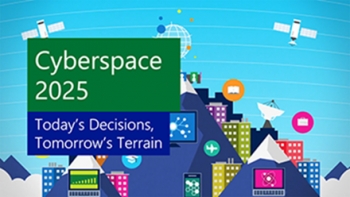For starters, more than 91% of people in developed countries will have ‘internet dependence’ – and a staggering 69% of those in developing economies will be using the Internet in their daily lives - 4.7 billion users will rely on the Internet.
There will be technology haves, and have nots – the former will have better jobs, education, entertainment and live in prosperous times. The real key is that policy makers need to keep up and understand the risks and implications of technological change – it is a truism that the pace of technology changes faster than policy [governance] does.
The report Cyberspace 2025 by necessity has three scenarios – Plateau, Peak, and Canyon.
|
|
The Plateau (stable but stalled) scenario is characterized political, economic, and societal forces both bolstering and hindering technological progress and cybersecurity. Some governments have inconsistent policies and standards with varied levels of stakeholder participation and international cooperation, while other governments form clusters of open trade and foreign direct investment (FDI).
The Peak (connected and cooperative) scenario is characterized by clear, effective government policies and standards across economies, and strong collaboration between governments to support open trade and promote FDI. This is a scenario of innovation, in which ICT fulfils its potential to strengthen governance models, economies, and societies. The actions of governments, businesses, and societal organizations foster the widespread and rapid adoption of technology. The political, economic, and social support leads to accelerated economic and technology growth and improved global cybersecurity.
The Canyon (deepening isolation) scenario is characterized by obstructionist government policies and standards, protectionist stances, and isolation. This significantly restricts trade and FDI and undermines relationships across industrial sectors within countries as well as between countries. In this scenario, economic and technology growth is slower, with limited adoption of ICT and deep failures in cybersecurity.
The model predicts that by the year 2025, emerging economies will have overtaken developed countries as the larger market for in-home consumer electronics, with emerging economies comprising over 60 percent of the total global market – the continuing creation of a new middle class. This shift will require global technology suppliers to adapt their products to these new markets.
Two critical demographic shifts will occur by 2025. Developed countries face rapidly aging populations and falling birth rates, while emerging economies can expect more working-age adults because of rising birth rates. These changes will have a dramatic and lasting effect on resource needs and long-term economic sustainability.
In short, developed countries will have a lot of retirees and an age of entitlement attitude to budgets. Developing countries will have a hunger for knowledge and prosperity. Jobs will go where labour is most efficient and there will be international competition for talent, especially ICT enablers.
The report has three other caveats.
- That the world does not experience another event like 9/11 in 2001 (called a black swan event)
- That the Internet remains stable not hijacked by regions, trade, or ethnic groups
- That there is no unexpected event, such as a catastrophic cyber-attack, that could lead to a drastic change in the relationship between government and the private sector, such as a government takeover of portions of the ICT industry or the passage of draconian ICT regulation.
The report recommends
- Commit to an open, free internet where privacy is protected
- Advance cybersecurity risk management and coordination
- Harmonise laws and standards affecting cybersecurity
- Promote global free trade
- Invest strategically in infrastructure and research and development
- Enable talent mobility and retention
- Support the education of a modern workforce
- Develop cyber security norms for stability and security in cyberspace.






